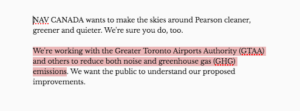 At 100+ decibels, the sound of a large jet nearing a runway’s end is as noisy as being in the front row of a rock concert. (Remember those?)
At 100+ decibels, the sound of a large jet nearing a runway’s end is as noisy as being in the front row of a rock concert. (Remember those?)
While the pandemic slashed the number of planes landing at and taking off from Toronto’s Pearson International Airport, business is picking up. And that means noise is coming back as a big issue for communities under the flight paths.
That’s a concern for the Greater Toronto Airports Authority, which runs Pearson, and NAV CANADA, which governs air navigation like flight arrival procedures. To their credit, they’ve been monitoring noise and sharing what they’re doing with the community. Are they being clear, though?
A piece on the NAV Canada website about an upcoming “Public Consultation” – with no mention of where or when until the end – called out for a “Before & After” treatment.
I ran the page through the Hemingway app to get a fast impression of how easy it is to read. The result? It’s not. In an issue of my newsletter, Wordnerdery, I show how getting to the point, reorganizing and rewriting the piece makes it more likely to be read and more easily understood.
Here’s the “before” version of the opening, clearly off to a bad start:

- It’s a 36-word sentence, flagged in pinky-red as very hard to read. The American Press Institute says this means readers will only understand about 30 to 39% of it (an average of 9 to 14 words = 90 to 99%).
- It’s written at a post-graduate level, typical of dense academic papers. Only about 4.5% of adults can comfortably read at this level.
- It doesn’t get to the point. The “Public Consultation” – the whole point of the piece, supposedly – isn’t even mentioned. That’s in the second-to-last paragraph, 314 words into the article.
Following the plain language standard of putting the most important information up front, I rewrote the opening to briefly set the stage and mention the public consultation. (The app flags the third sentence as hard to read but I think much of the blame falls on the lengthy name.)

The original piece continues with comments about the pandemic, including the overworked “unprecedented,” guaranteed to make eyes glaze over. (View the section in Wordnerdery.) There’s also some back-patting about the industry. And finally, finally, at the very end, we find out there will be public consultation. There’s no mention of where and when within the article, and it’s not obvious that you have to scroll quite far down the page to find out.
I cut out the blather about unprecedented times, took out the repetition of the GTAA acronym and used shorter words and sentences. I also got to the point, summed up as: “We need to act. Here’s how. We want to know what you think.”
You could argue that people annoyed about airplane noise will comment anyway, but no sense making it harder for them to do it.
Wordnerdery is a quick read about words, effective/expressive writing, newsletters and more. Are you a subscriber yet? If yes, thanks for reading! If not, you can sign up right now. In keeping with Canada’s anti-spam laws and just plain good manners, you can easily unsubscribe any time.
